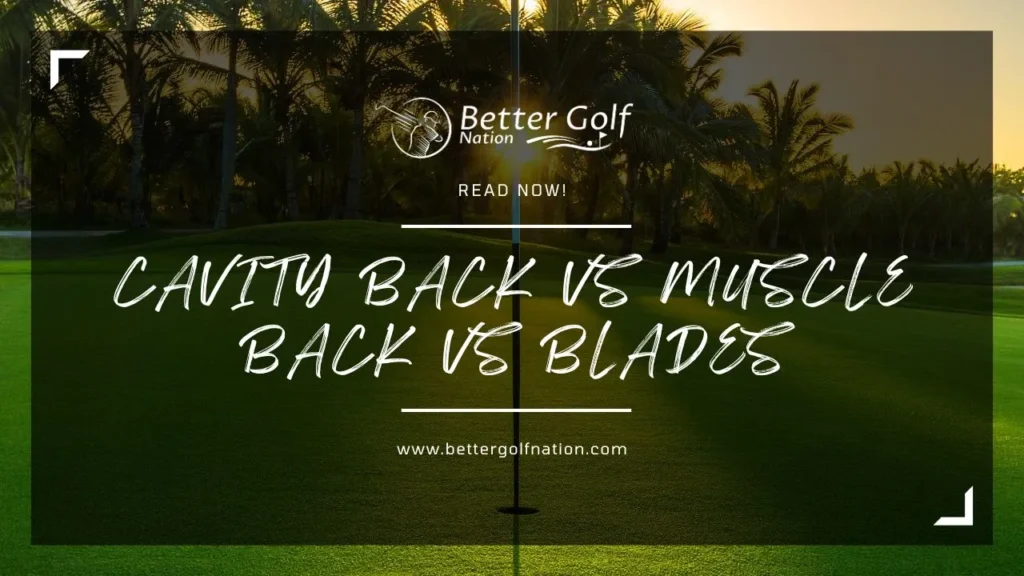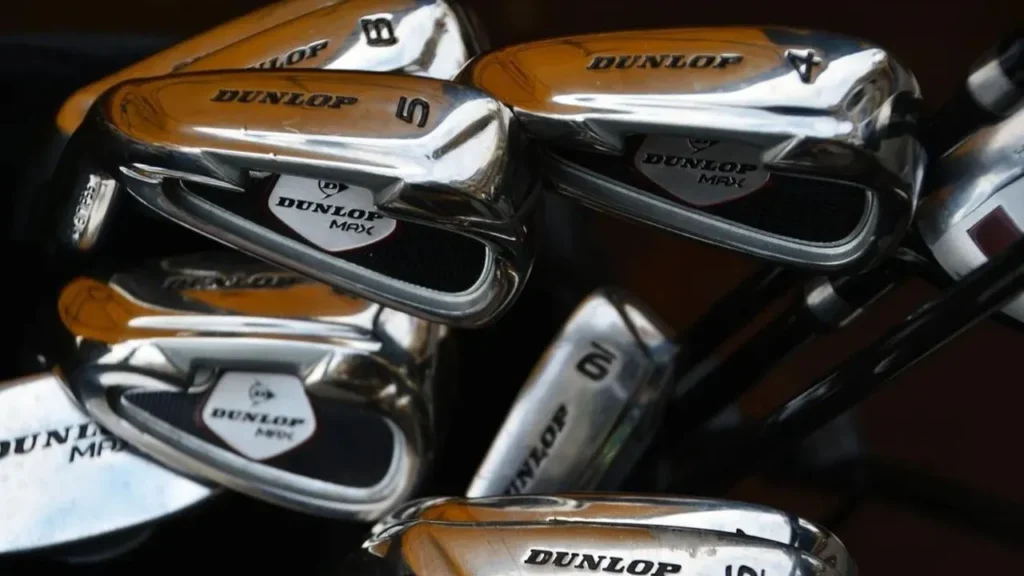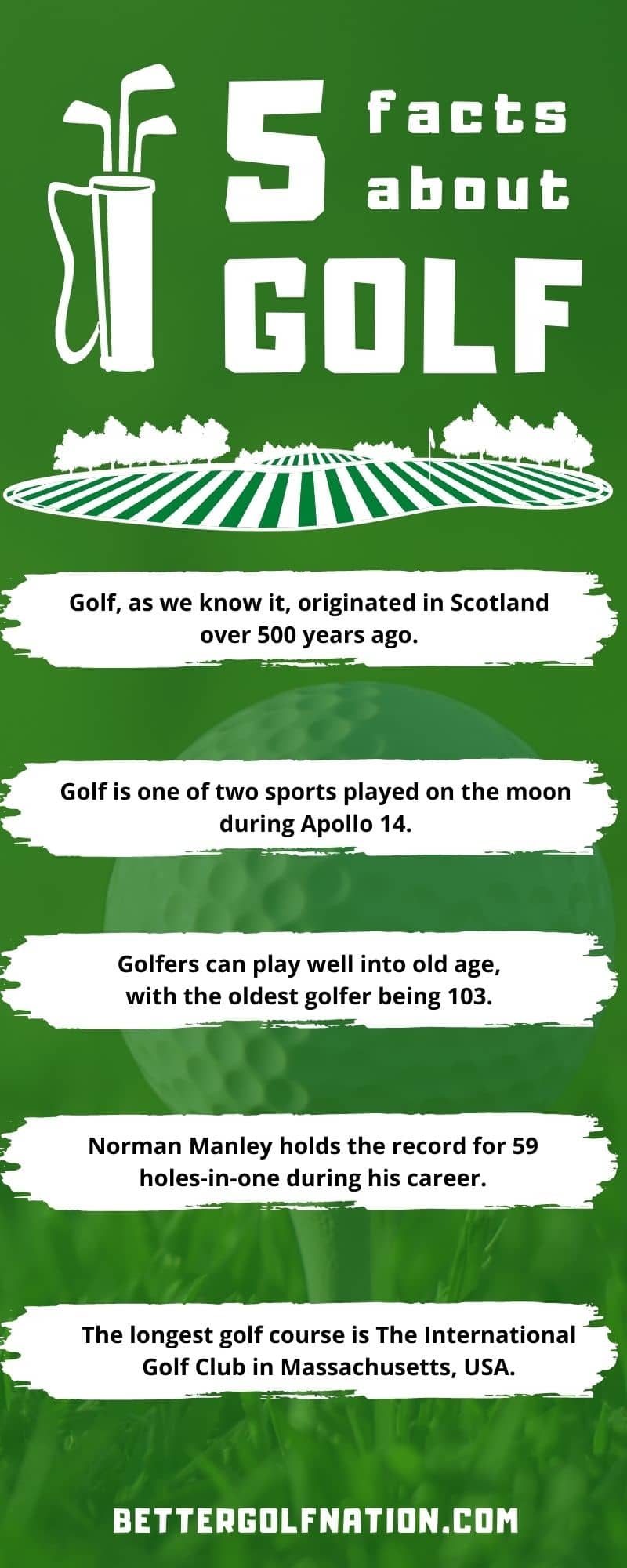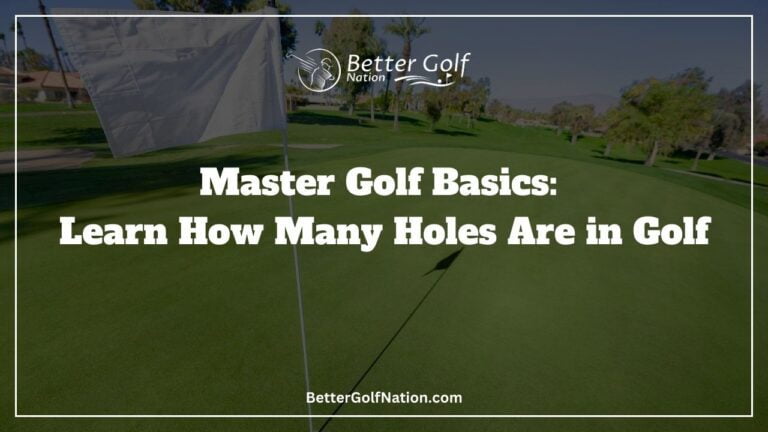Cavity Back vs Muscle Back vs Blades – The Iron Showdown
- Last updated on March 22, 2024
- Toni Benedito
- Golf Equipment & Gear, Blog
Cavity back, muscle back, and blades are three main types of golf irons. Cavity backs are forgiving and suitable for beginners, muscle backs offer control for skilled players, while blades provide precision but demand high skill. Understanding their differences helps choose the right irons for your game, whether prioritizing forgiveness, control, or precision.

Key Takeaways
- Cavity-back irons offer forgiveness with a perimeter-weighted design, making them ideal for beginners or high-handicap players needing straighter shots and higher trajectories.
- Muscle-back irons suit advanced players, providing shot-shaping capabilities and precise feedback, albeit with less forgiveness.
- Blades prioritize shot control and consistency, demanding perfect swings for optimal performance and being favored by skilled players for precise ball flight.
- Technology has blended blade-like features into cavity backs for added control, catering to players seeking shot shaping with some forgiveness.
- Choosing the right iron depends on personal skill level and preferences; understanding each type’s pros and cons is essential for improving overall golf performance.
Introduction
Golf is a game that requires skill, precision, and patience, and one of the most important aspects of golf is choosing the right club.
When it comes to irons, there are three main types to choose from: cavity back, muscle back, and blades. Cavity-back irons are designed to be more forgiving than muscle-back or blade irons.
They have a hollowed-out area on the back of the club head, which moves the weight toward the perimeter of the club. This design makes it easier for golfers to hit straighter shots and achieve a higher trajectory.
Cavity backs are ideal for golfers who are just starting or have a high handicap. Muscle-back irons are designed for more advanced players who have more control over their shot trajectory.
They have less forgiveness than cavity backs but allow players to shape shots more easily due to their design. They also provide more feedback on miss-hits due to their tough feel when compared with other types of irons.
Blade irons are considered by many golfers to be the best type of iron due to their ability to be consistent in terms of yardage and shot dispersion. However, they require perfect swings every time, as they offer no clemency when miss-hitting, even slightly off-center, resulting in shorter distances and less accuracy.
Enjoying this article? Read more:

Check out this video below from the Out Of Bounds Golf YouTube channel, where they discuss which is best: Cavity Back, Muscle Back, or Blades:
Advanced technology has allowed blade-like features into cavity backs, which allow players with low handicaps to seek ball control and shaping capabilities with some forgiveness. Each type of iron has its pros and cons, depending on what you’re looking for in your game.
Cavity backs may not provide as much feedback or shot-shaping abilities as muscle backs or blades, but they offer consistent distances while being easier on miss-hits, which means you will hit longer yardages overall than with muscle backs or blades if you don’t hit perfectly every time. Muscle backs are great for players who can shape shots and want more feedback on their swings.
Blades require precise swings, but they can provide golfers with the best shot control and consistency. Choosing the right iron for your game can be challenging, so it’s important to get input from other golfers or a professional fitter.
It’s also a good idea to try out different types of clubs to see which one feels the most comfortable in your hands and fits your swing style. Ultimately, it’s down to personal preference, but understanding each club type will help you make a more informed decision, save strokes around the course, and improve your golf game overall.

Understanding Different Types of Golf Irons
When it comes to golf irons, there are several different types that golfers can choose from. Understanding the differences between these types is crucial to picking the right equipment for your game. In this article, we will explore three of the most popular types: cavity back, muscle back, and blades.
Cavity back irons are typically designed for golfers with high handicaps or intermediate players who need more pardoning on off-center hits. They have a hollowed-out back, which redistributes weight to the perimeter of the clubface.
This makes them easier to hit and can improve shot trajectory by correcting slight mishits. Cavity backs also tend to have more bounce than other types of irons, which makes them ideal for wedge clubs.
Muscle-back irons are generally preferred by more skilled golfers due to their flexibility and response. The center of gravity is located closer to the center of the clubface, which gives players more control over shot shaping and distance.
"Understanding the differences between cavity back, muscle back, and blades is crucial to picking the right equipment for your game. Cavity backs offer forgiveness for off-center hits, while muscle backs provide more control. Blades give ultimate precision but demand skill. Choose the iron that matches your skill level!"
Muscle backs are often made from metal instead of cast iron, which allows for greater customization options in terms of loft and lie angle adjustments. Blades are another type of iron that is commonly used by pro golfers due to their ability to be consistent under demanding circumstances.
They have a small sweet spot located near the center of the face, making them less forgiving when struck off-center compared to cavity backs or muscle backs. Despite this drawback, blades offer maximum control over ball flight and spin rates, which allows experienced players to shape shots exactly how they want them.
Understanding the differences between cavity back, muscle back, and blades is essential before deciding on what type of golf iron you should use during play. Cavity backs offer an advantage for beginner or intermediate-level golfers who struggle with consistency, while muscle backs provide a happy medium between control and forgiveness.
Blades offer ultimate precision but require extreme skill and precision from their users, as well as practice and consistent swing quality. Ultimately, the best type of iron to use depends on your individual skill level and playing style.
Enjoying this article? Read more:

Differences Between Cavity Back, Muscle Back, and Blades
There are three main types of golf irons: cavity backs, muscle backs, and blades. Each type has its own unique characteristics and is designed for different skill levels. Understanding the differences between these types can help you choose the right set of irons to improve your game.
- Cavity-back irons have a hollowed-out back cavity that redistributes weight around the perimeter of the clubhead. The design makes them a more forgiving club for intermediate- to high-handicap golfers. They feature larger heads with deeper faces, which make it easier to hit and produce a higher ball flight. The cavity-back design shifts the center of gravity towards the sole, which helps players get their shots in the air quickly.
- Muscle-backed irons are designed for elite golfers who need more flexibility in their play. They usually have thinner top lines and smaller clubheads than cavity backs. Muscle-back irons provide better feedback on mishits but require a higher level of skill to play well consistently. These clubs offer less pardon than cavity backs but reward good shots with excellent responses.
- Blades are also known as “muscle-back” or “the player’s iron.” These clubs typically feature a thin top line, small head size, and minimal offset at address, making them an ideal choice for advanced players seeking greater control over their shots’ shaping and distance control. Blades offer consistent feedback on contact but can be challenging to hit correctly due to their small hitting zone.
When analyzing irons’ bounce capabilities (the angle between the leading edge and ground), blade-style designs are usually considered low-bounce; they provide little assistance when trying to get out of tricky lies or bunker situations compared to both muscle-backed and cavity-backed designs. In general, choosing between these three iron types depends on your skills as a golfer and what you want out of your game experience on the course.
Cavity-backs are great for beginners who need more forgiveness in their play, while blades are for advanced golfers who want more control and response. Muscle backs offer a balance between these two types, providing feedback on mishits while still offering forgiveness and consistency for players at an intermediate skill level.
Enjoying this article? Read more:

Check out this video below from the Golf Sidekick EXTRAS YouTube channel, where he looks at the difference between Blade Irons and Cavity Back Irons:
Pros and Cons of Each Type of Iron
Each type of iron comes with its own set of advantages and disadvantages. Let’s delve into the specifics of each type and the benefits they offer for your golf game.
Cavity-Back Irons
Pros:
- Forgiveness: With a larger hitting area and perimeter weighting, cavity-back irons offer more forgiveness for mishits, making them ideal for beginners or high-handicap players.
- Distance Control: These irons typically produce a straighter trajectory, aiding in better distance control and shot estimation.
Cons:
- Limited Shot Shaping: Cavity-back irons lack the flexibility to shape shots left or right, which may not suit more experienced golfers seeking greater play versatility.
- Feedback: While they provide some feedback on clubface impact, it may not be as detailed as other iron types.
Muscle-Back Irons
Pros:
- Shot Shaping: Muscle-back irons excel in shot shaping and offer precise feedback on every hit within the striking zone.
- Control: They provide superior control over both distance and trajectory, making them favored for approach shots and tight fairways.
Cons:
- Forgiveness: Due to less perimeter weighting, mishits with muscle-back irons can result in decreased distance and accuracy compared to other iron types.
Blade Irons
Pros:
- Shot Control: Blades offer unparalleled control over shot shaping, thanks to their slim profile and responsive feel.
- Feedback: They provide the most detailed feedback of any iron type, detecting even minor mistakes in your swing.
Cons:
- Skill Requirement: Blade irons demand a high level of skill and precision to wield effectively, making them challenging for beginners or high-handicap players.
- Forgiveness: Blades are the least forgiving type of iron, punishing mishits with potential loss of distance and accuracy.
Each type of iron caters to different player preferences and skill levels. Understanding your requirements on the course is crucial in selecting the right iron for your game. Whether you prioritize forgiveness or shot feel, there’s an iron suited to elevating your performance—it’s all about finding the perfect fit for your needs!
Enjoying this article? Read more:
Check out this video below from Sydney Golf Tech‘s YouTube channel where he looks at Blade, Cavity and Muscle Back Irons:
Choosing the Right Iron for Your Game
When it comes to choosing the right iron for your game, there are a few factors to consider. First and foremost is your skill level.
Players with low handicaps who have more advanced skills are typically better suited for muscle back or blade irons. These clubs offer greater control and feedback, but they require a lot of skill to use effectively.
For those with higher handicaps or less experience, cavity-back irons are often the best choice. These clubs have a larger sweet spot and are easier to hit consistently, making them ideal for players who need more forgiveness on off-center hits.
Additionally, cavity-backed irons usually have more advanced technology built in, providing players with greater distance on their shots. Another important factor to consider is the type of shots you want to be able to hit on the course.
If you want to be able to shape your shots with greater precision, muscle-back or blade irons offer the flexibility needed for such an approach. However, if you’re looking for a more forgiving club that offers clemency when it comes to hitting difficult shots, then cavity backs may suit you better.
In terms of bounce, muscle backs typically have less bounce compared with cavity backs, which tend to have more bounce. This means that the leading edge of blade/muscle backs will make contact earlier than that of cavity backs during impact, which can cause digging in softer terrain like bunkers.
Ultimately, there is no “best” type of iron; it’s all about finding what works best for your individual game and playing style. Don’t be afraid to ask other golfers or professionals at your local golf shop for input and analysis when making your decision; their expertise can help lead you in the right direction toward choosing an iron set that will help lower your scores on the course!
Enjoying this article? Read more:

Conclusion
Choosing the right type of iron for your game is crucial to improving your play and enjoying the game of golf. It’s essential to understand the differences between cavity back, muscle back, and blade irons so you can determine which one suits you best. For beginners or intermediate players who want more consistency and straighter shots, cavity-back irons are a great choice.
They offer a larger optimal hitting area and more forgiveness on off-center hits, providing more flexibility in play. Additionally, they tend to be longer than muscle-back or blade irons, making them a better choice for players who struggle with their distance.
Muscle-back irons are ideal for players with low handicaps who want more control over their shots. The design allows for more input from the player’s swing, resulting in a greater ability to shape shots.
While they require more skill to use effectively than cavity-backed irons, muscle-backed irons offer advantages such as improved feel and feedback from each shot. Blade irons are best suited for advanced players looking for complete control over their game.
These clubs allow skilled players to shape shots precisely and provide excellent feedback on every shot. However, they are not forgiving on off-center hits and require skillful input from the player’s swing.
Ultimately, it comes down to personal preference and playing style when selecting an iron set that works best for you. Consider factors such as your handicap level, playing goals, and preferences when determining which type of iron will give you optimal performance on the course.
Whatever choice you make in your selection of new golf clubs, take heart, knowing that every professional golfer started somewhere! So go out there with confidence; try them all out at demo days or borrow some from friends; then make an informed decision based upon what feels comfortable—because ultimately that comfort will translate into better scores on the course!
FAQs
Are muscle backs and blades the same?
Not quite! Both are forged irons with minimal forgiveness, but muscle backs have a slightly thicker cavity for improved feel and launch.
Are blades better than cavity backs?
There’s no “better” – it depends on your skill level. Blades offer superior feel and workability, but cavity backs provide more forgiveness on off-center hits.
Do pros use blades or cavity backs?
Many tour pros use blades for ultimate control, but some opt for cavity backs for added forgiveness on long irons.
What's the advantage of blade irons?
Blades offer the purest feel and allow for precise shot shaping, ideal for skilled golfers who can consistently hit the sweet spot.
Are blades harder to hit than cavity?
Yes. Blades have a smaller sweet spot, so mishits result in greater distance loss and direction issues compared to cavity backs.
Why are cavity backs easier to hit?
Cavity backs have a larger sweet spot and perimeter weighting for more forgiveness. This means off-center hits won’t lose as much distance or accuracy.
Are muscle backs hard to hit?
Similar to blades, muscle backs are less forgiving than cavity backs. They require a good swing for consistent results.
Do blades go farther than cavity backs?
Not necessarily. Distance depends more on swing mechanics. Blades may offer a slight advantage for skilled players due to lower launch angles, but cavity backs can be easier to launch for more distance.
What is considered the most forgiving irons?
Game-improvement irons, with their oversized heads and perimeter weighting, offer the most forgiveness for beginners and high-handicappers.
What does MB stand for in irons?
MB stands for “Muscle Back,” referring to the iron design where most of the clubhead weight is concentrated in the clubface.
Share this Post
Toni Benedito
Keep Reading
Follow Us
Recent Posts

The Shocking Cost: How Much Does It Cost to Fly with Golf Clubs?
Flying with golf clubs can be a hassle, but it’s worth it for avid golfers. Costs vary by airline, ranging from $30 to $150 per way. Southwest Airlines offers a generous policy, allowing one set

Why Do Golfers Tape Their Fingers Before Hitting the Course?
Golfers tape their fingers to prevent injuries from repetitive motions, provide support for existing injuries, and improve grip comfort. It’s a popular technique among amateurs and pros alike, offering a lightweight and effective solution compared

How Much Does a Round of Golf Cost? Are You on Par?
The cost of a round of golf varies widely based on factors like course type, location, and time of play. Public courses typically range from $30-$100 per round, while exclusive ones like Augusta National or

Hidden Fees: How Much Does It Cost To Rent a Golf Cart
Wondering how much it costs to rent a golf cart? Explore factors like location, rental duration, and cart type impacting prices. Daily rates range from $50 to $80, while weekly rentals can vary from $200

How Much Does a Golf Bag Weigh? The Ultimate Guide
Golf bag weight varies depending on type and materials, ranging from 2 to 70 pounds. Factors include stand bags for carrying, cart bags for carts, and tour bags for professionals. Consider bag weight for game

Hitting Driver Too High? How to Fix It for Lower Flight!
Discover why hitting the driver too high affects your golf game. Learn how swing mechanics, setup adjustments, and proper equipment can help you hit longer and more accurate drives. Key Takeaways Improving swing mechanics through
Table of Contents








